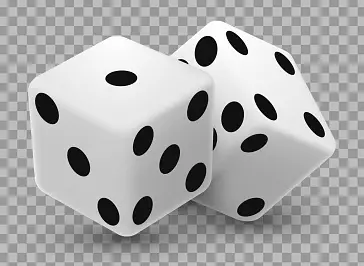In this article, we will see how to calculate probabilities associated with throwing six-sided unbiased dice. Since we are assuming that the dice are unbiased all six outcomes on a die are equally likely. We shall use the following formula for calculating probability:
Required Probability = Number of favourable Outcomes/Number of total Outcomes.
Single Dice Probability:
On throwing a single unbiased die there are six possible outcomes and each has a one out of six chance of occurring. Hence the probability distribution looks like this,
| Outcome | Probability |
| 1 | 1/6 |
| 2 | 1/6 |
| 3 | 1/6 |
| 4 | 1/6 |
| 5 | 1/6 |
| 6 | 1/6 |
How to calculate single dice roll probability:
- Given a particular event identify which of the above six outcomes is favourable to the occurrence of that event. An example is an event of the form: The number on the die is less than x. Then we have x-1 favourable outcomes
- Count the total number of favourable outcomes.
- Use the formula, Required Probability = Number of favourable Outcomes/Number of total Outcomes.
Examples of single dice roll probability:
- Suppose you want to calculate the probability that you get a number less than 4. Here the favourable outcomes are {1,2,3} so we see that the required probability is 3/6=0.5
- Suppose you want to calculate the probability that you get an odd prime number. Here the favourable outcomes are {3,5} so we see that the required probability is 2/6=0.333
- A single six-sided die is rolled. Find the probability of getting a number less than 3. Here the favourable outcomes are {1,2} out of 6 possible outcomes so we see that the required probability is 2/6=0.333
Two dice roll probability:
In this case, we have 62=36 possible outcomes because we have six possible choices for the first die and another six choices for the second dice. The sample space is as shown below:
{(1,1)(1,2)(1,3)(1,4)(1,5)(1,6)
(2,1)(2,2)(2,3)(2,4)(2,5)(2,6)
(3,1)(3,2)(3,3)(3,4)(3,5)(3,6)
(4,1)(4,2)(4,3)(4,4)(4,5)(4,6)
(5,1)(5,2)(5,3)(5,4)(5,5)(5,6)
(6,1)(6,2)(6,3)(6,4)(6,5)(6,6)}
How to calculate two dice roll probability:
- Given a particular event identify which of the above thirty-six outcomes is favourable to the occurrence of that event. An example is an event of the form: The sum of the numbers on the two dice is 4. Here the favourable outcomes are {(1,3)(2,2)(3,1)}.
- Count the total number of favourable outcomes.
- The total number of outcomes is 36 as seen in the above sample space
- Use the formula, Required Probability = Number of favourable Outcomes/Number of total Outcomes.
Probability Distribution table for the sum of numbers on the two dice:
The sum of numbers on two dice can vary from 2 up to 12. We construct the probability distribution table using the above procedure.
| Sum of numbers on two dice | Probability |
| 2 | 1/36 |
| 3 | 2/36 |
| 4 | 3/36 |
| 5 | 4/36 |
| 6 | 5/36 |
| 7 | 6/36 |
| 8 | 5/36 |
| 9 | 4/36 |
| 10 | 3/36 |
| 11 | 2/36 |
| 12 | 1/36 |
| TOTAL = 1 |
As expected the sum of all probabilities is equal to 1. Also notice that the probability distribution is symmetric.

5 Dice Roll Probability:
When a total of five dice are thrown together then we have a total of 65=7776 possible outcomes. This is because there are six possible outcomes for each of the five dice, so we multiply six by itself five times.
In order to calculate the probabilities associated with the rolling of five dice, we divide the number of favourable outcomes by 7776. If we are told to calculate the probability of getting four 6’s and one 5, then the favourable outcomes are:
(5,6,6,6,6) (6,5,6,6,6) (6,6,5,6,6) (6,6,6,5,6) (6,6,6,6,5)
Since there are five favourable outcomes, therefore,
Required Probability = Number of favourable Outcomes/Number of total Outcomes = 5/7776 = 0.006
Probability calculation for ‘n’ dice (Calculating probability when two or more dice are thrown):
If we throw ‘n’ dice then we have 6n possible outcomes. For example, if we were to throw 10 dice we would have 610 possible outcomes.
We clearly see that it is not possible to enumerate the entire sample space for calculating probabilities since the total number of outcomes is very large. In these cases, we use the multinomial distribution to calculate the associated probabilities.